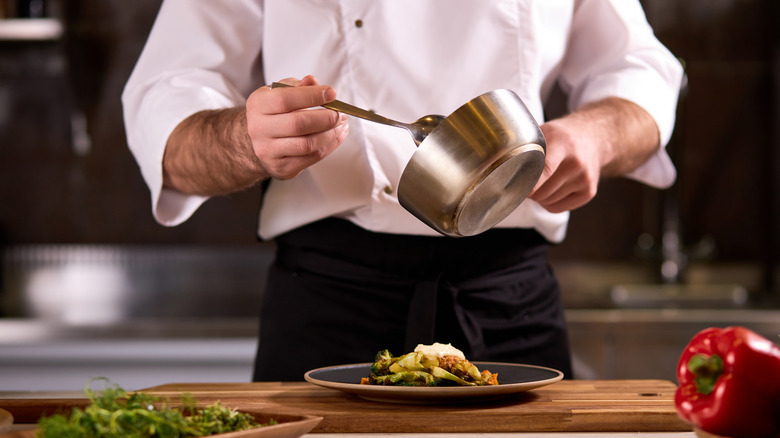The Leftover Ingredient Restaurant Chefs Swear By For Flavorful Sauces
You already know that Parmesan cheese is amazing just by what it brings to the table on pasta night. Whether it's shredded for you in a package, or you're freshly grating it over a dish, a pile of cheese holds a special place on top of any spaghetti. You can even have as much as you like on your salad at The Olive Garden — seriously, they won't stop until you say so. But parmesan isn't just a one-trick sort of cheese. High-quality, aged Parmesan Reggiano can do a lot of culinary heavy lifting, and even hold its own next to the chevre and cheddar on a cheese board.
Aged Parmesan is known as "the King of Cheeses" (per Forbes) and is great for cooking because it has a low moisture content and a rich, full flavor, so it's a fast way to add cheesiness to anything without needing to make many adjustments for extra water or melting, from a bowl of popcorn to a batch of scones. It's also an easy way to elevate a side of vegetables like asparagus or to give an omelet a little kick.
Parmesan can do more than add cheesy flavor, however. In fact, professional chefs are big fans of stockpiling their parmesan rinds after all the usable cheese is grated away and using them to make stocks, soups, and sauces that are next level.
Save the rinds
Once upon a time, people used to routinely toss parmesan rinds in the trash after they scraped away all the softer cheese they could from a chunk of the golden stuff. But thankfully chefs and cooks have evolved and learned to save the rinds, partially because real, authentic Parmesan Reggiano is expensive. A wheel of the good stuff can cost around $1,000 according to Insider, more than twice as much as regular cheddar.
Another reason to keep the rinds is to cut down on food waste. The U.S. Food and Drug Administration estimates that as much as 30% to 40% of the American food supply gets wasted each year, and in 2018 more than 63 million tons of food were wasted in the U.S. While parmesan rinds probably don't seem like a lot of waste, each little bit you could be using for food instead of tossing in the trash counts.
French chefs like Jacques Pépin know that saving some of the ingredients that normally get discarded pays off not just in your wallet but on the plate, and you can follow this principle by repurposing your rinds the way the pros do it. Just because you can't grate them for eating doesn't mean there aren't lots of great flavors left in the hard, waxy heels. The trick is to add them to hot water and extract the flavor, just like bones for stock.
Simmer for flavor
If you want to get some out-of-this-world flavor into your sauces and soups, try adding a few parmesan rinds when you're making a homemade stock that you'd use for a recipe base. They don't add a cheesy flavor, just a rich savory quality because they are packed with umami-rich glutamates (per Insider), which are the same molecules that make soy sauce, kelp and mushrooms taste rich and earthy.
Cooking with parmesan rinds is as easy as popping a few in with the vegetables and bones if you're making stock, and letting them simmer along with the rest of the ingredients. When you're done just strain the rinds away with the other solids. You might even simply toss one into a batch of vegetable soup and let it simmer to add some flavor, and then remove it before serving.
If you eat a decent amount of parmesan from the wheel (not pre-grated), save up your rinds by popping them in the freezer until you have five or six for a batch of stock or broth. If you don't eat enough blocks, ask your local cheesemonger to save you some, or you can sometimes find them wrapped up for sale at the cheese counter at Wegmans and Whole Foods.


